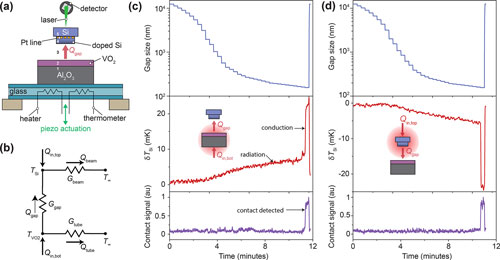| Posted: May 24, 2018 | |
A thermal diode based on nanoscale thermal radiation(Nanowerk News) Recently, the possibility of using phase-transition materials for near-field radiative heat transfer (NFRHT) has garnered increased attention. Of particular interest has been vanadium dioxide (VO2), which undergoes a phase transition from insulator below 68°C to a metal above that temperature. |
|
| This phase change causes a dramatic alteration of the infrared optical properties of VO2, leading to correspondingly dramatic changes in the NFRHT in response to relatively small temperature changes of the VO2 near the transition temperature. | |
| In new work, published in ACS Nano ("A Thermal Diode Based on Nanoscale Thermal Radiation"), researchers explore rectification in the near-field – where heat fluxes are much larger than those in the far-field and can exceed the blackbody limit of far-field thermal radiation – and demonstrate that rectification coefficients between VO2 and doped Si can exceed 50% in the near-field for moderate temperature differences (70 K) and gap sizes (140 nm). | |
 |
|
| (a) Schematic of the suspended, microfabricated device and VO2 on sapphire suspended on a glass tube (not drawn to scale). The temperature of both devices can be controlled and measured independently. The position of the bottom device is controlled via piezoelectric actuation. Deflection of the top device due to mechanical contact is detected optically. (b) Thermal resistance network showing the major heat transfer pathways in our system. (c) Time series data acquired during a single experiment, for whichΔT = +10 K (forward bias, i.e., TVO2 > TSi, see middle panel inset). Top panel: Evolution of vacuum gap size over time. Second panel: Temperature rise δTSi of the Si mesa device over time. Lower panel: Optical contact signal over time. (d) Same as in (c), but for an experiment with ΔT = -10 K (reverse bias, i.e., TSi > TVO2, see middle panel inset). (© American Chemical Society) (click on image to enlarge) | |
| These results show that the heat fluxes in these near-field diodes are much larger than what can be accomplished in the far-field. | |
| The team mathematically modeled their system to highlight the physical mechanisms responsible for this rectification and used their model to predict the optimal thicknesses at which rectification ratios are maximized. | |
| "The results and approaches developed here have important implications for probing near-field thermal devices such as diodes and transistors, which can significantly impact future heat-based computing and thermal management in nanoscale systems, energy conversion devices, and thermal circuits," the authors conclude their report. |
 By
Michael
Berger
– Michael is author of three books by the Royal Society of Chemistry:
Nano-Society: Pushing the Boundaries of Technology,
Nanotechnology: The Future is Tiny, and
Nanoengineering: The Skills and Tools Making Technology Invisible
Copyright ©
Nanowerk LLC
By
Michael
Berger
– Michael is author of three books by the Royal Society of Chemistry:
Nano-Society: Pushing the Boundaries of Technology,
Nanotechnology: The Future is Tiny, and
Nanoengineering: The Skills and Tools Making Technology Invisible
Copyright ©
Nanowerk LLC
|
|
|
Subscribe to a free copy of one of our daily Nanowerk Newsletter Email Digests with a compilation of all of the day's news. |
